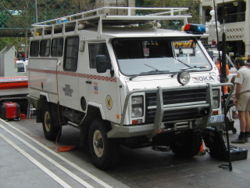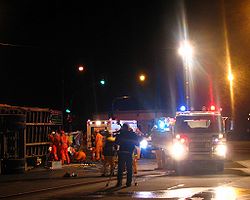
State Emergency Service
Encyclopedia



Australia
Australia , officially the Commonwealth of Australia, is a country in the Southern Hemisphere comprising the mainland of the Australian continent, the island of Tasmania, and numerous smaller islands in the Indian and Pacific Oceans. It is the world's sixth-largest country by total area...
n volunteer organisation that provides emergency help during and after declared (natural or otherwise) disasters. The SES is also the primary or secondary agency for emergencies, such as storm damage,flood damage, building damage, traffic hazards and road crash rescue. In other scenarios the SES may provide a support role to other agencies, particularly police and fire.
The SES is operational 24 hours a day 7 days a week.
History
The Civil Defence ServiceCivil Defence Service
The Civil Defence Service was a civilian volunteer organisation established in Great Britain by the Home Office in 1935. In 1941, during World War II, the use of Civil Defence replaced the pre-existing Air Raid Precautions...
began in Australia in 1955. It was formed as a precaution to any potential attacks on Australian soil. The name was changed to the "State Emergency Service" (abbreviated to "SES") during the 1970s, to reflect a change of emphasis into providing emergency help related to floods, storms and other natural emergencies. Every state and territory in Australia has its own State (or Territory) Emergency Service, and there are 43,000 volunteers spread across the country. Each state or territory is broken into regions, then units, and finally groups or teams.
The SES is one of many public safety organisations using AIIMS (Australasian Inter-Service Incident Management System). Typically, small incidents (AIIMS type 1) are assigned to a 'unit' and dealt with by a 'team'. AIIMS type 2 or 3 incidents are coordinated at the regional level.
Functions of the SES
The SES provides assistance to local communities in times of need. Because every community is different, every SES Unit has a slightly different set of roles and activities. Depending on the needs of the local community, a Unit may perform only some or all of these roles:| Function | Description |
|---|---|
| Agency Support (Operational) | Supporting other Emergency Services during incidents with lighting, human resources, marine transport, and other services. |
| Agency Support (Training) | Supporting other Emergency Services, agencies, and community organisations with member participation, resources, and welfare. |
| Air Observation - Search | Assisting in searches over land and sea from both helicopters and fixed-wing aircraft. |
| Air Observation - Intelligence | Gathering Flood Intelligence during events, emergency evacuation, remote area resupply, Reconnaissance of Flood and Storm effected areas. |
| Crowd and/or Traffic Control | Assisting police and ambulance at public events like ANZAC Day in this capacity. Also assisting police with road closures during events like flooding and New Year celebrations. |
| Emergency services liaison | Working with representatives of other emergency services during emergencies. |
| Evacuation Centre Management | Establishing and running temporary evacuation centres. |
| Fire Support & Training | Assisting the police and the rural and metropolitan fire services with road closures, evacuations, delivery of welfare during major fires, and some training like First Aid and Chainsaw Operations. |
| First Aid | Aiding members of the public requiring basic medical aid and assisting ambulance officers and members of St. John Ambulance of Australia with triage and mass casualty situations |
| Flood and storm preparation and response | Making temporary repairs and protecting property after floods and storms, helping people prepare for floods and storms and using specialised equipment like flood boats and chainsaws. |
| General rescue procedures and skills | Working safely to remove people from dangerous situations |
| Land Search | Searching for missing persons usually in rural areas but also in suburban areas |
| Management | Helping the Unit to run smoothly |
| Marine Rescue | Working with the Coast Guard and other marine organizations in assisting boats in distress |
| Media, public relations and community education | Working with the media and the public to communicate safety messages and warnings and to promote the SES to the community |
| Mines Rescue | Some SES units have specific training to allow them to rescue trapped persons from inside collapsed mines |
| Road-crash rescue | Rescuing people from crashed vehicles |
| Training coordination | Helping to plan and carry out the training in a Unit. Nationally recognised subjects and courses are available to members. |
| Urban Search and Rescue (USAR) | Extending basic rescue techniques to situations such as collapsed or unstable structures, using specialised equipment such as after bombs or explosions |
| Vertical rescue | Rescuing people from heights and depths such as cliffs or ravines |
| Tsunami & earthquake response | Responding to and managing tsunami and earthquake events |
| Welfare | Providing and administrating temporary field bases for activations, including meals, peer support, teas & coffees etc. The SES also runs a "driver reviver" scheme that aims to reduce accidents caused by fatigued drivers. |
Funding
In addition those funds are provided by legislation to the SES by state and local governments, SES groups also supplement their financial resources with donations made by individuals, businesses, and other government grants. These donations typically contribute to purchasing or maintaining groups' equipment such as vehicles and tools, or to improvements of the SES groups' property and facilities.The SES encourages members of the community to donate via stalls set up at local events (eg. school fetes or other community-based events).
Contacting the SES
The telephone number for all SES units is 132 500, except in the Northern Territory, where there is no state-wide telephone number. However, in a life-threatening emergency, Triple-zero (000)000 emergency
Triple Zero is the primary national emergency number in Australia. The Emergency Call Service is operated by Telstra a condition of its telecommunications licence, and is intended only for use in life-threatening or time-critical emergencies...
should be contacted instead.
External links
- Australian Council of State Emergency Services
- Australian Capital Territory State Emergency Service
- New South Wales State Emergency Service
- Northern Territory Emergency Service
- Queensland State Emergency Service
- South Australia State Emergency Service
- Tasmania State Emergency Service
- Victoria State Emergency Service
- Western Australia State Emergency Service
- Queensland Disaster Management Act 2003

